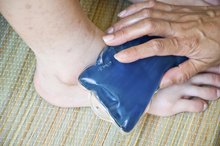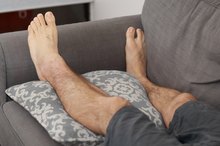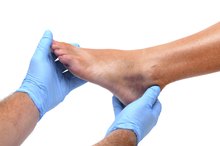Ankle Tendinitis Symptoms and Treatment
Ankle tendinitis refers to short-term inflammation of the tendons that surround the ankle joint. Tendons are fibrous tissue that connect muscle to bone and enable movement of the joint. Thirteen tendons cross the ankle joint. Ankle tendinitis can occur with increased use or an ankle injury, such as a sprained ankle. Pain and swelling are the most common symptoms. Various treatments focus on decreasing pain and inflammation and improving function of the ankle.
Pain and Tenderness
Ankle tendinitis causes pain, which may occur at the back, front or sides of the ankle, depending on the tendon or tendons affected. The pain typically increases with activity that puts stress on the inflamed tendon. It may also be worse when you first get out of bed in the morning. Applying pressure in the area of the inflamed tendon is often painful. Pain can also be generated by the presence of swelling.
- Ankle tendinitis causes pain, which may occur at the back, front or sides of the ankle, depending on the tendon or tendons affected.
- Applying pressure in the area of the inflamed tendon is often painful.
Swelling
What Are the Treatments for Tendinitis of the Foot?
Learn More
Swelling along the inflamed tendon is another common symptom of ankle tendinitis. However, it might not be noticeable initially. Swelling is likely to increase if treatment is not initiated to control the inflammation. Although the swelling is usually located in the area of the inflamed tendon, it can also be seen in the surrounding tissues of the ankle.
- Swelling along the inflamed tendon is another common symptom of ankle tendinitis.
- Although the swelling is usually located in the area of the inflamed tendon, it can also be seen in the surrounding tissues of the ankle.
Rest, Ice, Compression and Elevation
Self-care treatment of ankle tendinitis symptoms can be initiated by following the acronym R.I.C.E., which stands for rest, ice, compression and elevation. Staying off your feet as much as possible while avoiding running and jumping activities allows the tendon inflammation to resolve. Applying a cold pack to the area for 10 to 15 minutes at a time several times a day for the first few days helps reduce pain and swelling. An elastic ankle wrap gently compresses the ankle, which helps decrease pain and swelling. Elevating the ankle also helps reduce swelling and pain.
- Self-care treatment of ankle tendinitis symptoms can be initiated by following the acronym R.I.C.E., which stands for rest, ice, compression and elevation.
- Elevating the ankle also helps reduce swelling and pain.
Exercise and Medication
Symptoms of a Torn Tendon in the Big Toe
Learn More
Over-the-counter medications such as ibuprofen (Advil, Motrin) or naproxen (Aleve) can reduce inflammation in the tendon, leading to decreased pain and swelling with ankle tendinitis. Check with your doctor to be sure these medications are safe for you. Gentle stretching exercises -- such as ankle circles and stretching the calf muscle -- may also be helpful. These exercises serve to strengthen the ankle joint while maintaining its flexibility and reducing stiffness. However, it's important not to perform exercises that cause pain in your ankle, as this may further damage the inflamed tendon.
- Over-the-counter medications such as ibuprofen (Advil, Motrin) or naproxen (Aleve) can reduce inflammation in the tendon, leading to decreased pain and swelling with ankle tendinitis.
- However, it's important not to perform exercises that cause pain in your ankle, as this may further damage the inflamed tendon.
Medical Treatment
If your ankle pain does not improve within a few days with self-care, see your healthcare provider for evaluation and treatment. See your healthcare provider right away if you experience severe ankle pain, cannot bear weight or move your ankle, or your foot becomes cold, pale or numb. These symptoms may indicate a serious ankle injury.
Related Articles
References
- OrthoInfo: Achilles Tendinitis
- American Family Physician: The Injured Ankle
- American Orthpaedic Foot and Ankle Society: Ankle Fracture
- Essential Orthopaedics; Mark D. Miller, M.D., et al.
- International Journal of Therapeutic Massage and Bodywork: Tendinopathy: Why the Difference Between Tendinitis and Tendinosis Matters
- American Academy of Orthopaedic Surgeons. OrthoInfo. Achilles Tendinitis. Reviewed June 2010.
- American Academy of Orthopaedic Surgeons. OrthoInfo. Arthritis of the Foot and Ankle. Reviewed March 2015.
- American Academy of Orthopaedic Surgeons. OrthoInfo. Ankle Fractures (Broken Ankle). Reviewed March 2013.
- Arthritis Foundation. Arthritis and Diseases that Affect the Ankle.
- Robati S, Porter K, Shahid M, Crompton T, Sandiford N. Ankle osteomyelitis: an unusual presentation. JRSM Short Rep. 2013;4(6):35. doi:10.1177/2042533313476682.
- Merck Manual Consumer Version. Tarsal Tunnel Syndrome. Revised March 2018.
- U.S. National Library of Medicine. MedlinePlus. Common peroneal nerve dysfunction. Reviewed August 7, 2017.
- Mascard E, Gaspar N, Brugières L, Glorion C, Pannier S, Gomez-brouchet A. Malignant tumours of the foot and ankle. EFORT Open Rev. 2017;2(5):261-271. doi:10.1302/2058-5241.2.160078
- Tiemstra JD. Update on acute ankle sprains. Am Fam Physician. 2012;85(12):1170-6.
- American Academy of Orthopaedic Surgeons. OrthoInfo. Sprained Ankle. Reviewed February 2016.
- Arthritis Foundation. Lab Tests for Diagnosing Ankle Problems.
- Merck Manual. Professional Version. Cellulitis. Reviewed September 2019.
- American Academy of Orthopaedic Surgeons. OrthoInfo. Compartment Syndrome. Reviewed October 2009.
- American Academy of Orthopedic Surgeons. (n.d.). Arthritis of the Foot and Ankle.
- American Academy of Orthopedic Surgeons. (n.d.). Sprained Ankle.
- Koehler SM, Eiff P. (2018). Overview of Ankle Fractures in Adults. Asplund CA, ed. UpToDate. Waltham, MA: UpToDate Inc.
- Mascard E, Gaspar N, Brugieres L, Glorion C, Pannier S, Gomez-Brouchet A. Malignant tumours of the foot and ankle. EFORT Open Rev. 2017 May;2(5):261-71.
- Robati S, Porter K, Shabid M, Crompton T, Sandiford N. Ankle osteomyelitis: An unusual presentation. JRSM Short Rep. 2013 Jun;4(6):35.
Writer Bio
A registered nurse for 20 years, Mary Atkinson Smith, is also a nurse practitioner and educator who has experience in wellness, chronic disease management, end of life care, and surgical-related care. Smith has a doctoral degree in nursing and has published manuscripts in various healthcare journals.







